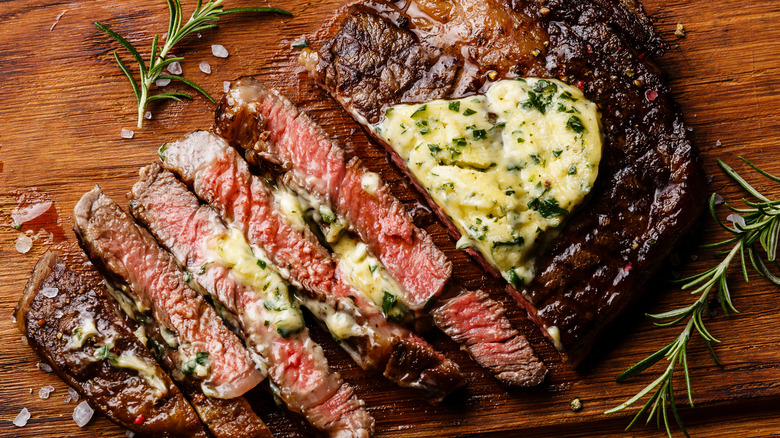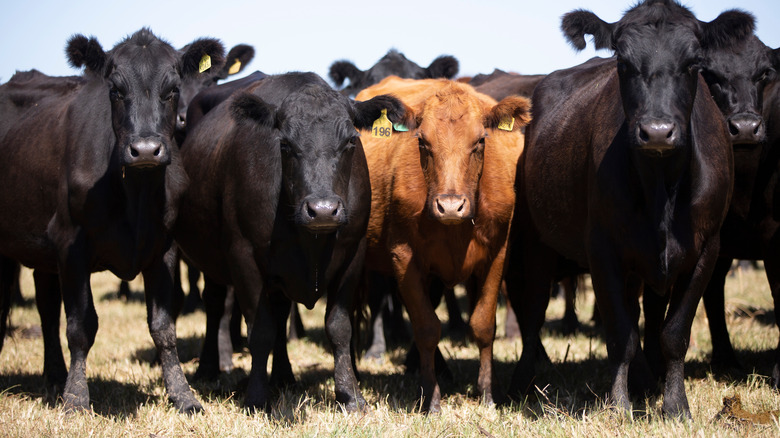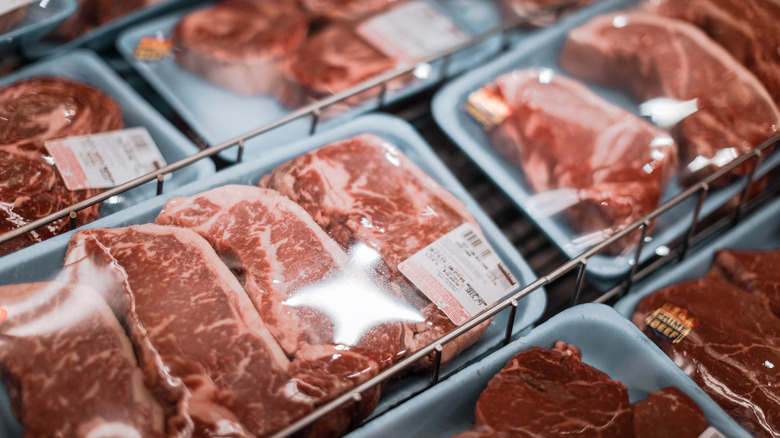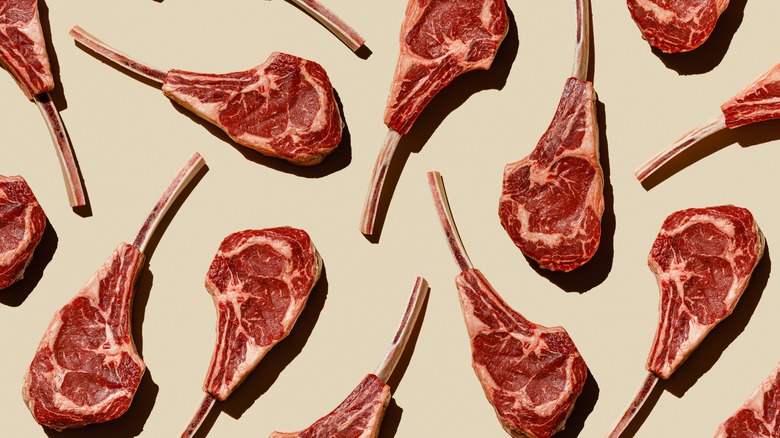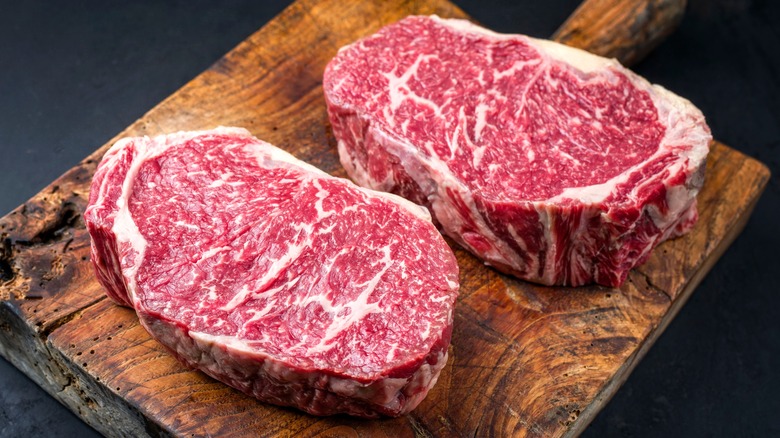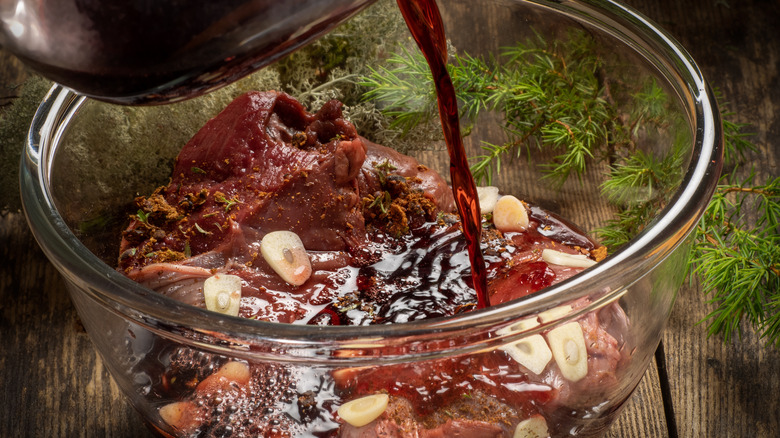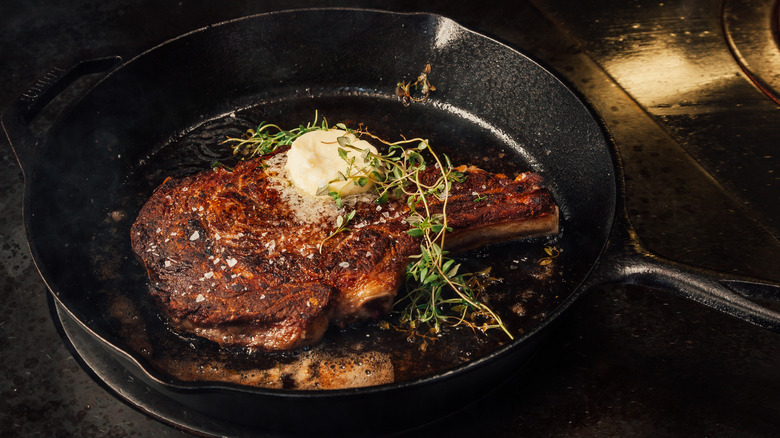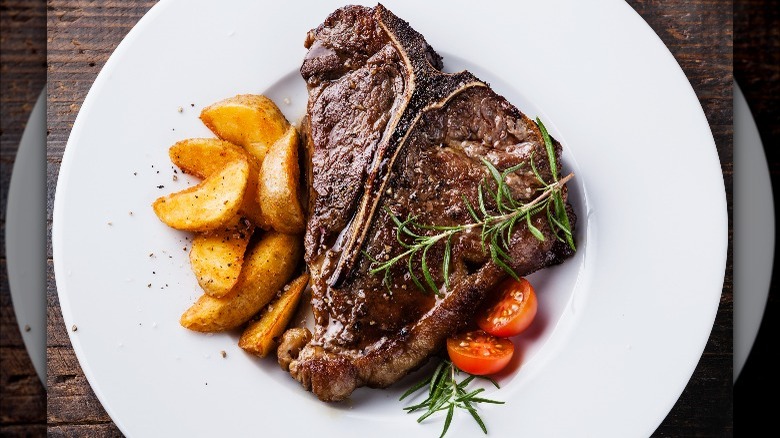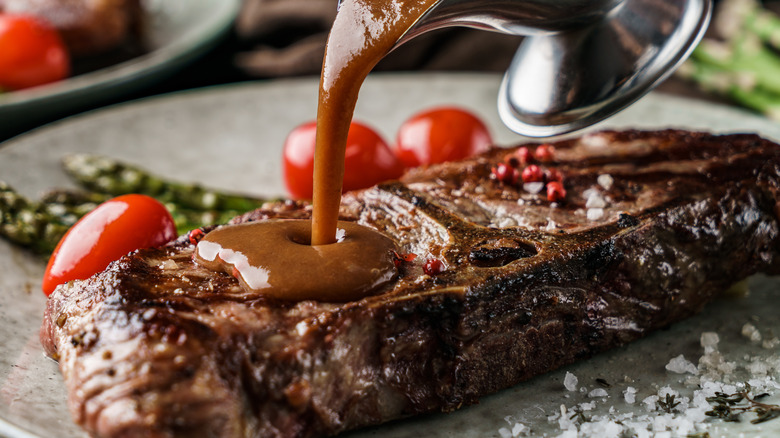10 Steak Myths You Can Stop Believing, According To Laurent Tourondel - Exclusive
There are few foods as universally revered as a good quality steak. It's a symbol of luxury, while simultaneously harkening to a simplistic, rugged way of life. You'll find steak everywhere, from the finest dining establishments, to the most down home country diners, as well as on weekly meal rotations in households across America. Steak does not discriminate. It's bougie, and yet at the same time it's a food of the people. (The USDA reports that roughly a quarter of the global population consumes beef regularly.)
Given its widespread appeal, it's no surprise that there are a lot of opinions and long-held ideas about what makes a good steak, and the best ways to prepare and serve it. Naturally, that means there's also a lot of misinformation out there when it comes to steak, which will only serve to confuse those who are looking to learn more about steak, and appreciate it both in restaurants and at home.
For some expert insight, we turned to acclaimed chef and steak savant, Laurent Tourondel. He's the chef behind the well-known BLT restaurant brand (though he's no longer affiliated), and currently runs more than a dozen eateries on the East Coast, including Miami's LT Steak & Seafood and the social media sensation that is Skirt Steak in New York City (if you've been, then you've no doubt waited in the line only to discover how worth the wait it was). Tourondel lent some of his wisdom to help us uncover some of the biggest steak myths to stop falling for, whether you're grilling at home or treating yourself to a fancy filet dinner out on the town.
The best steaks come from outside the U.S.
The quality of a good steak ultimately comes down to the health and well-being of the cow that's producing it. And there's a lot of debate about where the best cows (and thus the best beef) come from. Some claim that Europe produces the best steaks, while others insist that Asia or South America is home to the highest-quality beef. Part of the reason for that is the difference in livestock regulations and quality standards around the world. Different countries and regions have their own set of rules surrounding animal treatment, commercial production, quality certifications, and more. For example, one of the biggest differences between European and American beef is the use of growth hormones: The European Union has banned hormone treatments on cattle raised for beef, while this practice is still allowed in the U.S.
But when it comes down to pure flavor and texture, you can't beat American beef, at least according to Chef Laurent Tourondel. He contends that steak that is sourced from the U.S. is hands down number one in the world due to the way cattle are fed here. Unlike in Europe and South America, "they're not totally grass-fed," says Tourondel. In the U.S., most cows are fed a corn-based diet for part of their lives, which typically makes for fatter cows whose meat has a richer, more buttery flavor.
You can't get great steak at the supermarket
We can all agree that steak is not created equal across the board. The source of the meat, the way it was raised, how long it was aged, and several other factors will impact the flavor and texture of your cut. It requires a certain degree of discernment to find the best quality beef for your budget and your tastes. Therefore, it's not surprising that experts such as butcher Dario Cecchini insist you should stop buying meat at the grocery store. However, chef Tourondel is not among the naysayers.
"Look, I buy some meat at the supermarket," he admits. It just requires a little extra work to examine the selections on the shelves. Always look for USDA-certified beef to ensure the meat has been raised under the highest federal standards. Pay attention to where the cattle was raised, and "look at the marbling on it," adds Touronodel. And above all else, ask for help. Tourondel notes that your best bet for finding great steak at the supermarket is to chat up the butcher. They can provide tons of valuable information about the origin, aging, and fat content of all the meat options available, so you can get the most bang for your buck.
Bone-in cuts make for better steaks
Perhaps one of the most commonly held beliefs about steaks is that bone-in is always better. Many a steak connoisseur will tell you that bone-in cuts are juicier, tastier, and overall superior to anything off the bone. The logic is that all the flavor from the bones (especially that nectar from Heaven that is marrow) will seep into the meat during the cooking process, adding layers of flavor.
As it turns out, this is nothing more than another steak myth that needs to be put to rest. Chef Tourondel says blind taste tests don't lie. "I cook one steak on the bone, one steak no bone, and you tell me the difference ... there's no difference." Other tests have shown that beef bones in particular are too thick, and are surrounded by so much collagen, that most of the flavor in the bones isn't even able to penetrate most of the steak.
Further exemplifying this is the number of high-profile steak eateries that feature boneless cuts of meat as the star of the menu. Chef Tourondel's wildly popular Skirt Steak in NYC offers –- you guessed it –- boneless cuts of skirt steak as the star attraction. Want more proof? Grab a seat at West Village hot spot 4 Charles Prime Rib, which serves up the most succulent cuts of boneless prime rib you'll ever taste. And Tampa's famous Bern's Steakhouse is famed for its filet mignon and decadent chateaubriand cuts.
When it comes to high-end steak, Wagyu always wins
The word wagyu elicits a very particular vision of luxury, even among those who don't consider themselves to be well-versed in the world of steaks. The breed is known for its extremely high fat content and heavy marbling. What's more, the type of fat and fatty acids found in wagyu beef melt very easily, creating a super rich and tender texture as it cooks. It's no wonder that it is considered by many people to be the king of beef.
But the truth is that not everyone considers wagyu to be the ultimate choice for a succulent steak. Chef Tourondel actually says he's "not such a fan of the wagyu," noting that the exceptional fat content may actually be too high. He suggests that an "amazing prime beef" can actually a better quality steak, and usually at a better value, too.
USDA prime beef is made from young, well-fed cows and is also known for its robust marbling. These are the steaks you're likely to find in fancy restaurants, and Tourondel says that when you see a prime steak available on the menu, or in the store, chances are you'll be getting a delicious, quality piece of meat. On the other hand, wagyu is a breed of cow, rather than a grade of meat, so there may be more inconsistency across the board. "I've had some bad wagyu ... it's not all good," he says.
The longer you marinate, the stronger the flavor
Marinades are a fantastic way to infuse your steak with unique flavors, help maintain a juicy texture (especially if you tend to overcook your meat a little), and create new taste experiences, even when you're cooking the same cut over and over. The meat soaks in the liquid, typically made with a fat (like oil), an acid, plenty of salt, and other flavor components like spices, herbs, and sweeteners. As the steak absorbs flavor from all the ingredients, it would stand to reason that the longer you marinate your steak, the stronger those flavors will be. But that's a misconception.
When it comes to a tenderizing steak marinade recipe, too much of a good thing can quickly make for a bad meal. Chef Tourondel says there is such a thing as over-marinating your steak, which can detrimentally impact both the flavor and texture of your meat. He says most steaks only need to marinate for about 30 to 40 minutes. After that, "you are going to deteriorate the flavor of the beef." And while you want to taste all those yummy ingredients you put in your marinade, the chef says it's good "to have it outside." But when you actually cut into and take a bit of the interior of the steak, "you want the beef flavor." Beyond having a negative effect on the flavor, it's also worth noting that over-marinating can cause the tendons in your meat to break down, ruining the texture and mouthfeel.
There are several effective ways to check for steak doneness
You could say that cooking a steak perfectly is a delicate balance of art and science. It takes practice and finesse to achieve an ideal medium rare (or whatever doneness you prefer) consistently. The heat source, type of pan, cooking fat, humidity, and more can all have an impact, and making all these factors work in your favor is arguably an art. But if we're being honest, the key to cooking steak to your exact liking is really more about the science.
There are several purported tricks out there for measuring steak doneness and knowing when to take it off the heat to rest. Some people claim they can eyeball it based on the outer appearance and color of the juices. Others rely on specific cook times. And many swear by the poke test, in which you press on the steak, and measure the doneness against the feel of your palm.
However, we're here to burst your bubble once and for all. The only way to accurately gauge steak doneness and get the cook that you want every time is to use a meat thermometer. Chef Tourondel makes one concession, admitting that, sure, "if you cook 20 steaks or 40 steaks every day, then after that, when you touch it with your finger, you know." But for everyone else –- which is pretty much all of us –- it's not really possible to get it right without a direct temperature measurement.
Whatever you do, don't cut into your steak while it's cooking in the pan
While there's some debate about the ways you can check for steak doneness with and without a thermometer, there's a pretty clear consensus across the board on at least one method. It's a hard and fast rule for many chefs and home cooks that you should never cut into your piece of steak while it is cooking on the grill or in the pan. The argument is that cutting into the flesh will release moisture, which could leave you with a drier steak when all is said and done. This is why it's important to let steaks rest after they come off the heat and before you dig into them.
However, there's a difference between fully slicing up a steak and making a small slit to check how the interior is cooking. The former will all but guarantee an unpleasant steak dinner but taking a tiny peak won't have much of an impact. "I do that sometimes," admits chef Tourondel. The important thing to keep in mind is that the hot juice in the steak and steam from the pan will probably make your steak appear less cooked than it really is, so be sure to remove the meat from the heat before it reaches your ideal internal color, because it will keep cooking as it rests. Of course, if you don't trust yourself to make the judgment, you're better off sticking to a thermometer.
You can make satisfyingly tender steaks in a sous vide
Steak is an old-school classic, and yet people seem to constantly be looking for new and exciting ways to cook and prepare it. One trend that has taken home cooks by storm is sous vide cooking. The French technique involves submerging vacuum-sealed food (typically a raw piece of meat, fish, or vegetables) into a hot water bath to cook until it reaches a specific internal temperature. Just check through TikTok and you'll see all kinds of sous vide cooking experiments involving pretty much anything you can think of. And that certainly includes steak. There are plenty of people who swear by sous vide steak, claiming it is the easiest way to get a perfectly, and evenly, cooked steak every time.
But Chef Tourondel recommends skipping the water bath. He warns that "sous vide breaks the texture of the meat." That's because the process of cooking a steak sous vide, which can take anywhere from one to four hours, can almost have the same effect as a slow cooker, softening the meat over time. Tourondel says the method is ideal for cooking chicken since "you're going to get moisture and tenderness." But this texture isn't as ideal when it comes to steak. "I want to have a bite to my steak," says Tourondel. "I want to feel what I'm chewing. I don't want a puree of beef."
The best way to serve a cut of steak is whole
Whether you're splurging at your favorite steakhouse or pulling out all the stops for a decadent dinner at home, you want to ensure your meal is done right from preparation to plating. And many people assume that means serving up a whole cut of steak every time. The idea is to let the steak shine in all its seared glory, and also assure restaurant diners that the meat has been rested to perfection, sealing in all the flavorful juices.
But it's actually not that cut and dry. It is totally acceptable, and sometimes more appropriate, to serve up a steak already sliced, with the beautiful pink flesh on display for your eyes to feast on before you even get a taste. Chef Tourondel notes that the choice of serving your steak whole or sliced depends on the aging. If your steak has been dry-aged "when you cut it, it's not going to bleed. But if it's a fresh steak and it's not aged, then when you cut it, it's going to lose a ton of blood ... that's not really appealing to have blood on the platter or on a plate." At Tourondel's own LT Steak and Seafood in Miami, an order of the wagyu skirt steak will come to your table pre-sliced, showing off the tender marbled texture of the meat.
If it's truly a great steak, you shouldn't eat it with any sauce
Steak is meant to be enjoyed for its rich umami beef flavor. Because of this, many people have come to assume that a great steak doesn't need any kind of sauce. And while it's true that you should always be able to enjoy a quality, well-cooked steak all by itself, that doesn't mean that your meal can't or shouldn't be elevated with a sauce that can complement the flavors of the meat. And chef Tourondel would agree that any grill master worth their salt won't take offense.
In fact, Tourondel himself is a huge fan of steak sauces, ranging from creamy to spicy to sweet and everything in between. Beyond your classic steak sauce, the chef says he enjoys a good quality barbecue sauce to accompany his steak, as well the kick you can get from a peppercorn sauce. On the more creative side, Tourondel is fond of an orange coriander steak sauce he created to beef up the flavor of his beef. And at his Skirt Steak restaurant, Tourondel serves up each one of its namesake offerings with a signature bearnaise sauce. The bottom line? If it's a truly great steak, it will shine no matter what, and a sauce will only enhance the experience, not water it down.
